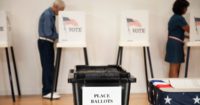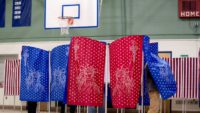Absentee / Mail-in Voting
All states have some form of absentee or mail-in voting due to federal requirements. These voters normally include military and overseas citizens, voters with disabilities and students who reside in a different state. For example, absentee or mail-in ballots are sent to these military and overseas voters 45 days prior to federal elections. However, absentee or mail-in voting is often limited by states to a number of valid excuses based on age, absentee status or an inability to vote on Election Day.
Some states have a greater number of reasons and valid excuses to vote absentee ballots by mail or in-person in an election office. A number of states have no-excuse absentee or mail voting. Lastly, a number of states have implemented an entire method of mail-in balloting that includes return of ballots to secure boxes or by postal mail. Oregon instituted an all-mail-in balloting system in 1998 and other states like Washington and Colorado have instituted similar all mail ballot methods of voting.
Mail-in and absentee balloting provides certain vulnerabilities to the electoral system:
- One stated general purpose for no-excuse absentee or mail ballot voting is to increase convenience and reduce long lines on Election Day. However, “Election Day” has become “Election Month,” which has increased the overall costs of election administration. County election offices that must process a large number of mailed ballots will experience significant delays in releasing official election results. A month or more of voting dramatically increases the overall costs to political campaigns for poll watching and get-out-the-vote efforts prior to Election Day.
- Mail-in ballots are not cast in the secure polling place where precinct poll workers can confirm addresses and verify identification. A great deal of voter fraud and abuse of absentee and mail-in ballots has been documented across the country. Absentee or mail-in balloting may spur a short-term increase in turnout in local elections; however, there is no evidence that voting by mail increases overall turnout for the long term in general elections.
- Absentee or mail-in balloting requires the use of the U.S. Postal Service (USPS) to transmit and return the ballot. This often causes delays to the election office. Citizens in states that use mail-in ballots often authorize the return of ballots to secure mail boxes that voters can use if they distrust the postal service.
A number of states authorize or require in-person absentee voting with verification by voter ID, and some states require a voter ID at the time of absentee or mail-in ballot request or return.
Alternatively, many states that allow absentee or mail-in voting use signature comparison to verify the identity of the voter. Many believe that signature verification is error-prone and not uniformly implemented by election officials across the country. While signature verification does catch a small percentage of invalid ballots or voter fraud, the system often fails to identify a great many irregularities associated with absentee or mail-in voting. Alternatively, many argue that signature verification routinely disenfranchises thousands of voters when it is used to ferret out an invalid signature.
ACRU Commentary
News
A General’s analysis of the dangers of mail-in voting
Leave it to an Army general to analyze, summarize and finalize the dangers of mail-only voting, succinctly, using data, and then give marching orders to the concerned. In a letter to the North Carolina Pilot, Lt. Gen. Marvin Covault (ret.) uses years of experience and all three of his stars to recognize that mail-only voting is the enemy of vote integrity.
More proof that mail-only voting is an electoral train wreck
When it comes to fighting against universal mail-only ballots, ACRU is a purposeful broken record. We have noted repeatedly these ballots go to 1. The deceased. 2. People who moved. 3. Non-citizens. In Michigan, hundreds returned universal ballot applications that went to 1. The deceased. 2. People who moved. 3. Non-citizens. Addresses don’t vote, and politicians don’t listen.
California Court shuts down Governor’s mail-only ballot edict
California’s Democrat Governor Gavin Newsom is not a legislator and has no legal authority to demand an all mail election—only the state legislature does. This was recently explained to him by a California judge who read the law. According to the Election Integrity Project of California, about 648K people who are dead, moved, never voted, or over 105 years old would receive ballots under Newsom’s scheme. We call that open season for fraud.
All-mail ballots all messed up
Of the 2,400 Republicans in one New Jersey town requesting a GOP ballot for a July primary, nearly 700 received a Democrat ballot. When the Governor demanded an all-mail election, election clerks scrambled for print vendors. The owner of the printing company that made the mistake says it was “honest human error.” Add “honest human error” to the reasons why universal mail-only voting is a bad idea.
Congressman Thomas Massie (R-KY) posts and Tweets ACRU President Lori Roman’s recent oped “If You Can Go to the Grocery Store, You Can Go to the Polls” and helps ACRU’s message go viral!
"America has resources and institutional knowledge to make in-person voting work. There is no reason for American legislators to run scared. It is time to renew our commitment to free, fair, and secure in-person elections." Rep. Thomas Massie (R-KY) quotes ACRUs recent oped on the dangers of mail-only voting, and why it is unnecessary.
A citizen’s reminder: absentee ballots have not gone extinct
We are grateful to Mr. Brian Glass of Virginia, who points out in clear prose; 1. A list of confirmed cases of mail-in vote fraud; and 2. The difference between universal mail-in ballots and intentionally requesting an absentee ballot. Yes, we all know this, but sometimes the obvious things are lost in the debate. Everyone in America can still request an absentee ballot. With their name on it. That comes to their actual house.






